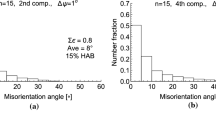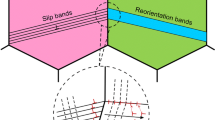Abstract—An approach, which is based on modified phenomenological models of the rheological behavior of metallic materials under superplasticity conditions, is proposed to describe the grain size distribution during superplastic flow with allowance for grain refinement. The characteristic features of experimental grain size distributions are shown to be successfully simulated.







Similar content being viewed by others
Notes
The importance of the idea of uniting groups to accelerate calculation in probabilistic models should be noted. According to their algorithm, the groups the strain rate of which having exceeded the critical rate do not disappear and lose part of their volume. In a further calculation, these groups continue to lose volume in each step and create new groups, which leads to explosive growth in the total number of groups if a union algorithm is not used.
REFERENCES
R. A. Vasin and F. U. Enikeev, Introduction to the Superplasticity Mechanics (Gilem, Ufa, 1998), Part 1.
T. G. Nieh, J. Wadsworth, and O. D. Sherby, Superplasticity in Metals and Ceramics (Cambridge University Press, New York, 1997).
O. I. Bylya and R. A. Vasin, “Deformation of alloys under superplasticity and similar conditions,” Izv. Tul’skogo Gos. Univ., Estestv. Nauki, No. 2, 116–128 (2011).
T.-W. Kim and F. P. E. Dunne, “Determination of superplastic constitutive equations and strain rate sensitivities for aerospace alloys,” Proc. Inst. Mechan. Eng., Part G: J. Aerospace Eng. 211 (6), 367–380 (1997).
I. A. Goncharov and T. A. Belyakova, “Methods for estimating the accuracy and stability of the algorithm of determining superplasticity model parameters,” Vychisl. Mekhan. Sploshn. Sred 11 (1), 51–67 (2018).
T.-W. Kim and F. P. E. Dunne, “Modeling heterogeneous microstructures in superplasticity,” Proc. R. Soc. London, A 455, (1982), 701–718 (1999).
O. I. Bylya, B. K. Pradhan, E. B. Yakushina, P. L. Blackwell, and R. A. Vasin, “Modeling of active transformation of microstructure of two-phase Ti alloys during hot working,” Letters on Mater. 4 (2), 124–129 (2014).
A. K. Ghosh and R. Raj, “A model for the evolution of grain size distribution during superplastic deformation,” Acta Metall. 34 (3), 447–456 (1986).
A. A. Sirenko, M. A. Murzinova, and F. U. Enikeev, “On the universal relationship between specific characteristics of superplastic deformation,” J. Mater. Sci. Letters 14, 773–774 (1995).
O. I. Bylya, R. A. Vasin, and A. I. Pshenichnyuk, “An approach for modeling the active transformation of microstructure of two-phase alloys in FEM simulation of technological chains in superplastic forming (SPF),” Mater. Werkstofftechnik 45 (9), 799–806 (2014).
Author information
Authors and Affiliations
Corresponding author
Additional information
Translated by K. Shakhlevich
Rights and permissions
About this article
Cite this article
Goncharov, I.A. Simulation of the Grain Refinement in Metals during Superplastic Deformation. Russ. Metall. 2019, 948–955 (2019). https://doi.org/10.1134/S0036029519100094
Received:
Revised:
Accepted:
Published:
Issue Date:
DOI: https://doi.org/10.1134/S0036029519100094




